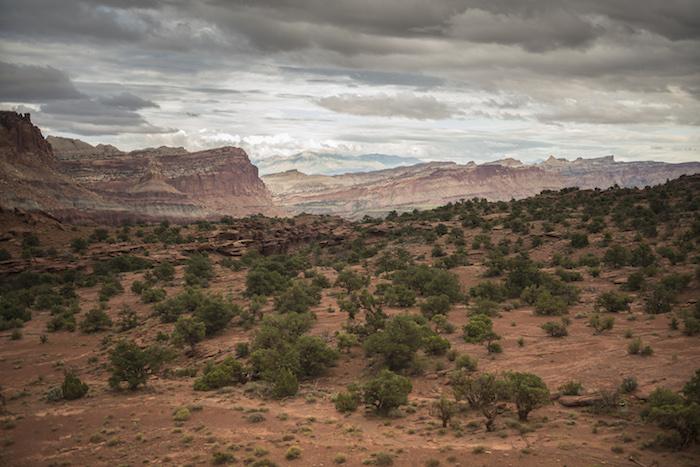
The staff at Capitol Reef National Park is taking public comment on a plan to continue to let cattle graze in the Waterpocket Fold District of the park/NPS file, Nathan Gross
Cattle grazing historically has been part of the landscape of today's Capitol Reef National Park in Utah. But does it remain a viable, or proper, activity in the park today? You can weigh in on that topic through August 17 on an environmental assessment the National Park Service has prepared on cattle in the park.
“Cattle grazing and trailing have historically been part of the park’s landscape and mandated use, which is why it is important that we develop a plan to continue that use while also preserving the park’s natural and cultural resources,” said Capitol Reef Superintendent Sue Fritzke. “As part of that process, we will continue to work with our permit holders, stakeholders, the public, and local, state and federal partners to ensure a collaborative final product.”
During the public comment period, the NPS will host one in-person meeting where staff will be available to discuss the EA. The meeting will be held from 6 p.m. to 8 p.m. on August 1 at the Wayne County Community Center, 605 South 350 East, Bicknell, UT 84715.
The preferred alternative in the EA seeks to minimize impacts to permit holders by keeping current trailing routes open and maintaining the same number of maximum Animal Unit Months in the active grazing allotment. The preferred alternative also incorporates widely-accepted management techniques, including pasture rotation, fencing, monitoring, and adaptive management to balance grazing and trailing with available forage. These techniques are intended to improve rangeland health and protect park resources, including threatened and endangered species, their habitat, and riparian areas. None of the alternatives included in the draft plan propose eliminating grazing and trailing within the park.
The EA will be available for public review and comment online via the Planning, Environment and Public Comment website. Hardcopies of the EA will also be available at local libraries and a limited number can be requested, as described on the planning website. Comments will also be accepted at the public meeting and via U.S. mail.
The planning process began with meetings, discussions, and scoping with Cooperating Agencies and the public in 2014 and 2015. The comments NPS received were used to help inform and develop alternatives and analysis that are now included in the EA. Similarly, NPS will use the comments received on this draft to finalize the plan.
When the NPS began the planning process, there were two active grazing allotments that existed within the park – the Hartnet Allotment in the Cathedral District and the Sandy 3 Allotment in the Waterpocket District. In early 2018, the Hartnet Allotment permit holder willingly sold their permit to a non-profit organization and thereby relinquished their rights to graze within the park, but retain the right to trail cattle.
As a result, the Park Service adjusted planning efforts for the livestock grazing and trailing management plan to address long-term management and permitting of grazing on the Sandy 3 Allotment. The EA also analyzes the effects of issuing permits on eight traditional livestock trailing routes that currently cross the park and the effects of issuing two new trailing permits to the former Hartnet Allotment permittee. Under current law, grazing will continue as long as the current generation of permit holders continues to operate. Trailing livestock across the park along traditional routes will continue indefinitely.



Comments
Cattle are not native to the area and cause damage, this is public land and the ranchers can buy there own land to run cattle on.
It's a bit more more complicated than that. The majority of grazing in the west occurs on public land, although the vast majority is BLM and Forest Service. NPS allows some grazing. Areas near me include Point Reyes National Seashore and Bolinas Ridge at Golden Gate National Recreation Area. I live in an area with nearby public parkland where the park district allows cattle grazing. I'm not making any judgement on this particular issue since I don't know that much about Capitol Reef, but grazing on preexisting allotments isn't all that unusual, and grazing on public land is pretty common in Utah and the rest of the west.
Here are links to a couple of articles about the history of Capitol Reef you may find interesting. And, when the park was enlarged and renamed as a national PARK, I believe part of the legislation involved included continuation of existing grazing.
https://www.nps.gov/parkhistory/online_books/care/adhi/adhi17.htm
https://www.nps.gov/care/learn/management/index.htm
https://www.nps.gov/care/learn/management/livestock-trailing-and-grazing...
The fact that livestock grazing is a widespread practice on America's public lands is not a compelling argument for its continuance. The native plants and animals - what's left of them - in the arid lands of the West can't take the pressure from the millions of non-native cattle and sheep, which are owned by a very small number of private operaters.
Here's a news report from just a day or so ago recounting deaths of several cattle in Capitol Reef that apparently starved to death:
https://www.ksl.com/article/46366615/officials-animal-cruelty-charges-po...
A bit of good news from down in the direction of CARE:
https://www.sltrib.com/news/environment/2018/07/27/gravel-pit-wont-pop-up/
I am writing because last July there were starving and dead cattle at Capitol Reef. Supposedly the owner was going to be charged, yet here we are once again - cattle starving at Capitol Reef.
When is someone going to do something about these starving and dead cows? It is cruelty, and a disgrace. Was anything ever done last July? These cows are at the entrance to Cathedral Valley, right off Route 24 near the 490 West Cathedral sign. Who is responsible for this area? Whose cattle are they? Is it the same owner as the prior cattle that died? Why isn't anything being done?
Please help these animals and find out why nothing is being done.
Thank you!